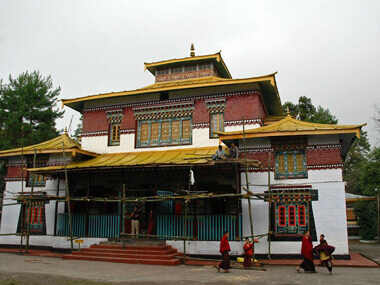About Sikkim
 Nestled between the Kingdoms of Bhutan and Nepal is a little known region called Sikkim. Now a province of India, Sikkim was an independent Kingdom until 1952 and is the overland gateway to Bhutan. Although the region has been populated by a huge range of Himalayan ethnicities Sikkim is still predominantly Buddhist. Famed for its amazing array of flora and fauna, our trips here offer all levels of trekker an intimate and beautiful mountain experience. Apart from seeing the 3rd highest mountain, Kanchenjunga up close you will meander through stands of Buddhist prayer flags, idyllic villages and lush forests full of colorful butterflies.
Nestled between the Kingdoms of Bhutan and Nepal is a little known region called Sikkim. Now a province of India, Sikkim was an independent Kingdom until 1952 and is the overland gateway to Bhutan. Although the region has been populated by a huge range of Himalayan ethnicities Sikkim is still predominantly Buddhist. Famed for its amazing array of flora and fauna, our trips here offer all levels of trekker an intimate and beautiful mountain experience. Apart from seeing the 3rd highest mountain, Kanchenjunga up close you will meander through stands of Buddhist prayer flags, idyllic villages and lush forests full of colorful butterflies.
Highlights: Panoramic views of Kanchenjunga, unspoilt Tibetan villages and culture, beautiful mountain vistas, giant butterflies fluttering through old growth forests.
Due to the extreme altitude, there is an immense variation in climate and vegetation. With a rainfall of about 140 inches in Gangtok, the climate is tropical up to 5,000ft, temperate between 5,000ft–13,000ft, alpine at 13,000ft, and snowbound at 16,000ft and above.
The best time to visit Sikkim is between mid-March and June but especially, April and May, when the rhododendrons and orchids are in bloom. However, temperatures can be high, especially in the valleys. During the monsoons, from the end of June until end September, rivers and roads become impenetrable, though plants nurtured by the incessant rain erupt again into bloom towards the end of August. October, when orchids bloom once again and November tend to have the clearest weather of all. As December approaches, it gets bitterly cold at high altitudes, and remains that way until early March, despite long periods of clear weather.
The best time to visit this zone is from mid September to mid December, although it gets pretty cold by December. The high seasons again starts from mid-march & continues till mid June. During monsoon months ie; from June to September, the view of the mountains gets obscured & rainfall is pretty heavy (270 cm annually).
Sikkim is the least populated state in India. There are three principal communities of Nepalese (75%), Lepchas (20%), and smaller proportions of Bhutias and Limbus. The Bhutias are Buddhist and so are most of the Lepchas. The Nepalese are chiefly Hindus. Lepchas or the Rong appear to be the original inhabitants of Sikkim as no legends of their migration are available. In the 13th century, the Bhutias from Kham area of Tibet came to the state. They believed in Buddhism of the Mahayana sect. The Nepalis were the last to enter Sikkim, in the mid 19th century.
All communities live in perfect harmony sharing each other’s cultures, ethos and traditions with the result that there is now a Sikkimese culture, which is composite of all the three prominent communities. Most of the people speak Nepali, which is also the state language. It is the harmony of the place that provides justification to the name of the state derived form Sukhim, meaning “happy home, a place of peace.”
Though Hinduism is equally followed, Buddhism is entrenched in the tradition of the state. The people have faith in the Buddha, the dharma (his teachings), and the sangha (assembly of monks) where religious texts are studied, taught and preserved. Soaked in the religious tradition, the land has a spiritual ambience where prayer flags with inscriptions of Buddhist texts flutter around the boundary of the village to ward off evil spirits, prayer wheels rotate to the currents of water, and chortens and lucky signs are common sights.
Foreigners require an Inner Line Permit (ILP) in addition to normal Indian visa to enter Sikkim and can visit Gangtok, Rumtek, Phodang and Pemayangtse. No permit is required to enter & stay in Darjeeling & other parts of North Bengal including Kalimpomg.
All foreigners intending to visit Sikkim can avail of 15 days inner-line permit with a further 15 days extension available in Gangtok. Re-entry into Sikkim is not possible within 3 months of leaving Sikkim. Restricted area permit for individuals & groups for restricted areas i.e., Gangtok. Rumtek, Phodong, Pemagyantse can be obtained in advance from all Indian missions aboard, Sikkim tourism offices at Delhi, Calcutta, Siliguri & Gangtok, after furnishing requisite documents. A standard Permit allows one to visit Gangtok, Rumtek, Phodong and Pemagyantse. The permits are checked and the visas stamped while entering and leaving Sikkim.
Foreigners without a valid passport and permit are not allowed to enter Sikkim. The best and the easiest way to get the permit is when the individual/group is getting their Indian visa stamp on their passport. All they have to do is express their desire to visit Sikkim & the Indian missions abroad endorses the permit while granting the India visa.
